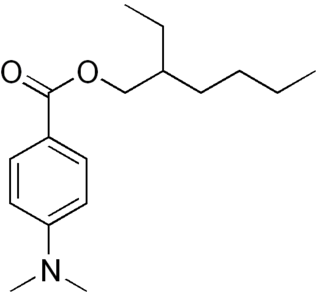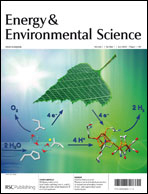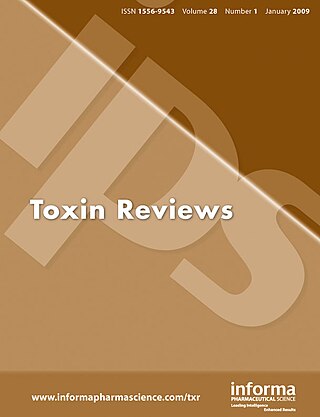Mutagenesis is a process by which the genetic information of an organism is changed by the production of a mutation. It may occur spontaneously in nature, or as a result of exposure to mutagens. It can also be achieved experimentally using laboratory procedures. A mutagen is a mutation-causing agent, be it chemical or physical, which results in an increased rate of mutations in an organism's genetic code. In nature mutagenesis can lead to cancer and various heritable diseases, and it is also a driving force of evolution. Mutagenesis as a science was developed based on work done by Hermann Muller, Charlotte Auerbach and J. M. Robson in the first half of the 20th century.

In biology, a mutation is an alteration in the nucleic acid sequence of the genome of an organism, virus, or extrachromosomal DNA. Viral genomes contain either DNA or RNA. Mutations result from errors during DNA or viral replication, mitosis, or meiosis or other types of damage to DNA, which then may undergo error-prone repair, cause an error during other forms of repair, or cause an error during replication. Mutations may also result from insertion or deletion of segments of DNA due to mobile genetic elements.
Genotoxicity is the property of chemical agents that damage the genetic information within a cell causing mutations, which may lead to cancer. While genotoxicity is often confused with mutagenicity, all mutagens are genotoxic, but some genotoxic substances are not mutagenic. The alteration can have direct or indirect effects on the DNA: the induction of mutations, mistimed event activation, and direct DNA damage leading to mutations. The permanent, heritable changes can affect either somatic cells of the organism or germ cells to be passed on to future generations. Cells prevent expression of the genotoxic mutation by either DNA repair or apoptosis; however, the damage may not always be fixed leading to mutagenesis.

Ethyl methanesulfonate (EMS) is a mutagenic, teratogenic, and carcinogenic organic compound with formula C3H8SO3. It produces random mutations in genetic material by nucleotide substitution; particularly through G:C to A:T transitions induced by guanine alkylation. EMS typically produces only point mutations. Due to its potency and well understood mutational spectrum, EMS is the most commonly used chemical mutagen in experimental genetics. Mutations induced by EMS exposure can then be studied in genetic screens or other assays.
Genetic variability is either the presence of, or the generation of, genetic differences. It is defined as "the formation of individuals differing in genotype, or the presence of genotypically different individuals, in contrast to environmentally induced differences which, as a rule, cause only temporary, nonheritable changes of the phenotype". Genetic variability in a population is important for biodiversity.

Padimate O is an organic compound related to the water-soluble compound PABA that is used as an ingredient in some sunscreens. This yellowish water-insoluble oily liquid is an ester formed by the condensation of 2-ethylhexanol with dimethylaminobenzoic acid. Other names for padimate O include 2-ethylhexyl 4-dimethylaminobenzoate, Escalol 507, octyldimethyl PABA, and OD-PABA.
Cell damage is a variety of changes of stress that a cell suffers due to external as well as internal environmental changes. Amongst other causes, this can be due to physical, chemical, infectious, biological, nutritional or immunological factors. Cell damage can be reversible or irreversible. Depending on the extent of injury, the cellular response may be adaptive and where possible, homeostasis is restored. Cell death occurs when the severity of the injury exceeds the cell's ability to repair itself. Cell death is relative to both the length of exposure to a harmful stimulus and the severity of the damage caused. Cell death may occur by necrosis or apoptosis.

The single cell gel electrophoresis assay is an uncomplicated and sensitive technique for the detection of DNA damage at the level of the individual eukaryotic cell. It was first developed by Östling & Johansson in 1984 and later modified by Singh et al. in 1988. It has since increased in popularity as a standard technique for evaluation of DNA damage/repair, biomonitoring and genotoxicity testing. It involves the encapsulation of cells in a low-melting-point agarose suspension, lysis of the cells in neutral or alkaline (pH>13) conditions, and electrophoresis of the suspended lysed cells. The term "comet" refers to the pattern of DNA migration through the electrophoresis gel, which often resembles a comet.

Xenobiotica is a peer-reviewed medical journal that publishes comprehensive research papers on all areas of xenobiotics. It is published by Informa plc and covers six main areas:

Energy & Environmental Science is a monthly peer-reviewed scientific journal publishing original (primary) research and review articles. The journal covers work of an interdisciplinary nature in the biochemical and biophysical sciences and chemical and mechanical engineering disciplines. It covers energy area. Energy & Environmental Science is published by the Royal Society of Chemistry and the editor-in-chief is Joseph Hupp.

Toxin Reviews is a quarterly peer-reviewed medical journal covering research on multidisciplinary research in the area of toxins derived from animals, plants and microorganisms. The aim is to publish reviews that are of broad interest and importance to the toxicology as well as other life science communities. Toxin Reviews aims to encourage scientists to highlight the contribution of toxins as research tools in deciphering molecular and cellular mechanisms, and as prototypes of therapeutic agents. The reviews should emphasize the role of toxins in enhancing our fundamental understanding of life sciences, protein chemistry, structural biology, pharmacology, clinical toxicology and evolution. Moreover, prominence is given to reviews that propose new ideas or approaches and further the knowledge of toxicology. Toxin Reviews delivers up-to-date research on toxins, their characteristics, activities, and mechanisms of action, ranging in scope from new, underutilized substances, through anti-venoms to chemical and biological weapons. It is published by Taylor & Francis Group. The editor-in-chief is R. Manjunatha Kini, National University of Singapore.
DNA Repair is a peer-reviewed scientific journal that covers cellular responses to DNA damage. Published monthly since January 2002 by Elsevier as the continuation of Mutation Research/DNA Repair, with Samuel H. Wilson as editor in chief. The journal publishes original research papers, short reviews, and book reviews concerning DNA repair, cell cycle regulation, cell death, and other biological responses to genetic damage.
The Environmental Mutagenesis and Genomics Society (EMGS) is a scientific society "for the promotion of critical scientific knowledge and research into the causes and consequences of damage to the genome and epigenome in order to inform and support national and international efforts to ensure a healthy, sustainable environment for future generations."
Toxicological Sciences is a monthly peer-reviewed scientific journal which covers all aspects of research on toxicology. It is published by Oxford University Press on behalf of the Society of Toxicology. It was established in 1981 as Fundamental and Applied Toxicology and obtained its current name in 1998. The current editor-in-chief is Jeffrey M. Peters, a professor of molecular toxicology and carcinogenesis at The Pennsylvania State University, and the Managing Editor is Virginia F. Hawkins. The editorial staff also includes Associate Editors in subject areas and an editorial board of topic experts. While its ISO 4 abbreviation is Toxicol. Sci. it is commonly referred to as ToxSci.
Food and Chemical Toxicology is a peer-reviewed scientific journal covering aspects of food safety, chemical safety, and other aspects of consumer product safety. It is published by Elsevier and was established in 1963. The editor-in-chief is José L. Domingo.

The Journal of Toxicology and Environmental Health is a peer-reviewed public health journal covering environmental toxicology. It was established in 1975 and in 1998 was split into Part A: Current Issues and Part B: Critical Reviews. According to the Journal Citation Reports, Part A has a 2012 impact factor of 1.733, whereas Part B has a 2012 impact factor of 3.896.
Archives of Environmental Contamination and Toxicology is a quarterly peer-reviewed scientific journal published by Springer Science+Business Media, covering environmental health and the effects of contaminants on the environment. It was established in 1973 and the editor-in-chief is Daniel R. Doerge. According to the Journal Citation Reports, the journal has a 2020 impact factor of 2.804.
Antimutagens are the agents that interfere with the mutagenicity of a substance. The interference can be in the form of prevention of the transformation of a promutagenic compound into actual active mutagen, inactivation, or otherwise the prevention of Mutagen-DNA reaction.
Biomicrofluidics is a bimonthly peer-reviewed scientific journal covering all aspects of research on fundamental physicochemical mechanisms associated with microfluidic, nanofluidic, and molecular/cellular biophysical phenomena in addition to novel microfluidic and nanofluidic techniques for diagnostic, medical, biological, pharmaceutical, environmental, and chemical applications. The editors-in-chief are Hsueh-Chia Chang and Leslie Y. Yeo.
The somatic mutation and recombination tests (SMARTs) are in vivo genotoxicity tests performed in Drosophila melanogaster (Fruit fly). These fruit fly tests are a short-term test and a non-mammalian approach for in vivo testing of putative genotoxins found in the environment. D. melanogaster has a short lifespan, which allows for fast reproductive cycles and high-throughput genotoxicity testing. D. melanogaster also has around 75% functional orthologs of human disease-related genes, making it an attractive in vivo model for human research. The tests identify loss of heterozygosity for the specified genetic markers in heterozygous or trans-heterozygous adults using phenotypically observable genetic markers in adult tissues. Although diverse events like point mutations/deletions, nondisjunction, and homologous mitotic recombination might theoretically cause this loss of heterozygozity, nondisjunction processes are generally not relevant for most of the examined chemicals. SMARTs are two different tests that use the same genetic foundation, but target different adult tissues and are named accordingly: the wing-spot test and the eye-spot test.







